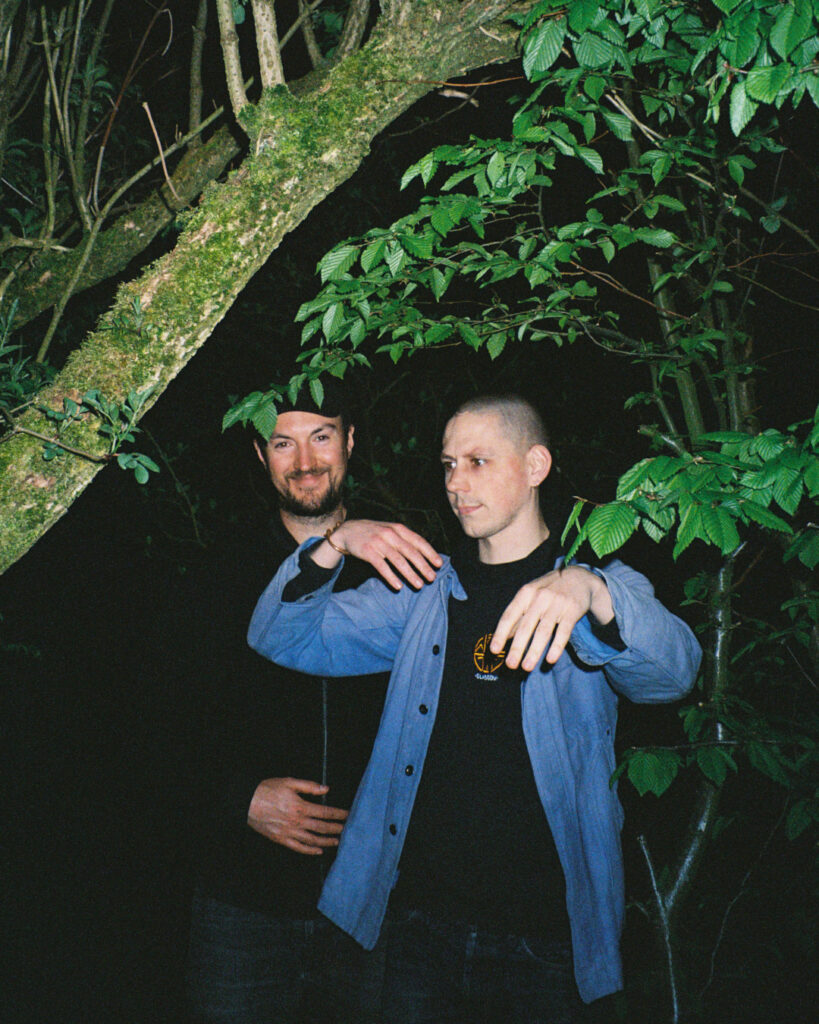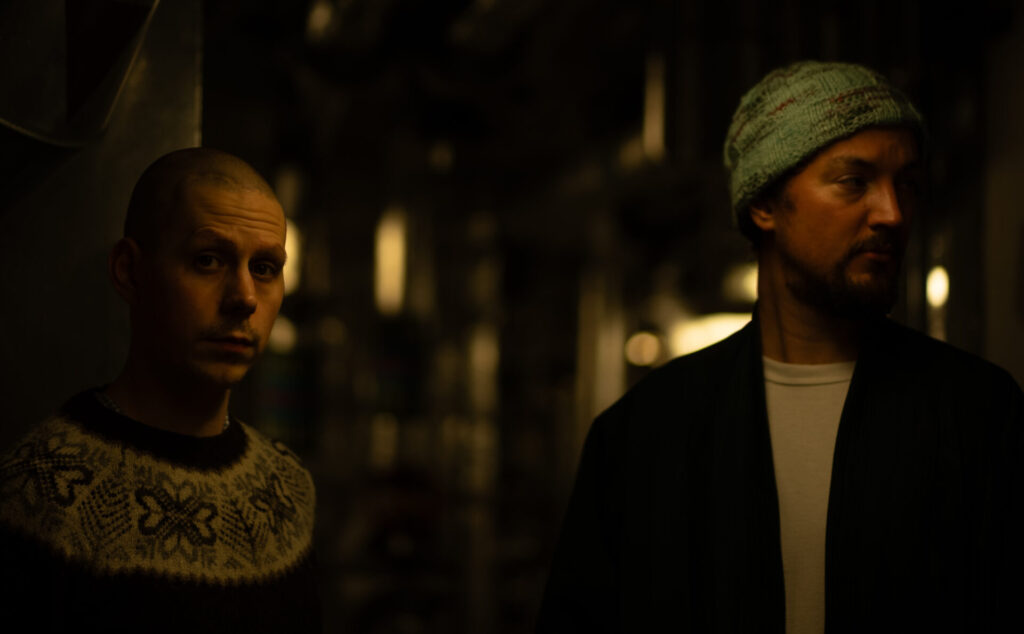In Shetland, there’s a folkloric creature known as the “trow” or “trowie”, similar to the Scandinavian troll. These mischievous hill-dwellers have a love of music and dancing, and many tunes in the island’s folk repertoire are said to have been authored by the creatures before being passed on to humans.
“Some people believe that these tunes are just written by humans who weren’t very confident with their own writing,” says Shetland-born musician Norman Willmore. “These tunes are so cool and slightly weird, and maybe don’t fit in with [the wider canon]. And I think it’s kind of sweet that some fiddler from the past didn’t want to take ownership of it, out of doing something different, and decided to pass it off onto a mythical creature.”
It’s one way of explaining the slight off-ness, or weirdness, of certain Shetland tunes relative to the wider Scottish folk tradition, an aesthetic which Willmore and fellow musician Corrie Dick have been exploring through their new album Twa Double Doubles. It’s the debut release for the duo who are geographically split, with Willmore now based in Glasgow and Dick, who is originally from Glasgow, in the south east of England. Both have a background in jazz, and through Scotland’s relatively small scene were acquainted for many years before a lull in lockdown prompted Dick to message Willmore about playing together.
“We definitely played some Sun Ra tunes at the start,” recalls Willmore. “And I think we just played things that were easy because we didn’t have time to rehearse. I’d already been playing [folk] tunes, so there was definitely that interest there. And we definitely played American folk tunes, it wasn’t specifically to do with Shetland at all, but it was like, diddly.”
For Willmore, time spent away from his home while studying at music college led to a deeper appreciation of his Shetland culture, and for Dick, who grew up hearing folk music, it was a comforting reminder of home. Fast-forward a couple of years, and the pair managed to win some funding from Creative Scotland. This led to two research trips to Shetland, where they visited local archives and spent time learning tunes from some of the leading tradition-bearers of the islands, one of them being Maurice Henderson from Fiddler’s Bid. They also researched collections held by Whalsay’s Heritage Of Song and Tobar An Dualchais, both archive repositories of Shetland’s folk traditions. Twa Double Doubles is the outcome of this research, consisting of Shetland tunes or Shetland-specific versions of wider folk tunes.
Owing to its island status, which isolated it from the mainland and exposed it to international trade and fishing routes, and the fact that the archipelago was part of Norway until the 15th century, Shetland’s music has a close affinity to Norwegian folk traditions and has developed differently to much of the mainstream Scottish repertoire. Fiddle-playing is a strong part of Shetland’s history, while there isn’t much of a pipe tradition unlike other parts of Scotland, for instance. The tuning of the fiddle also differs from the norm, known as ‘back tuning’, which creates the sound of ‘ringing strings’, a lasting influence of Norway’s Hardanger fiddle tradition. In terms of dance tunes, while the majority of Scottish dances are usually structured in 8-bar forms, the oldest Shetland ones are based on Muckle Reels, which are longer in form and less repetitive. According to Willmore, only a couple have ever been recorded and their playing died out around the end of the First World War
Outside of Norman&Corrie, there is a growing trend amongst British and Irish musicians who are looking beyond the well-known folk tunes and traditions, choosing instead to undertake archival research and experiment creatively with the findings. Lankum have used archival field recordings and printed music collections for the basis of their albums, while up-and-coming Fermanagh-based musician Róis has released an album which re-imagines the pre-Christian tradition of keening in Ireland while interweaving the original field recordings. In Wales, harpist and singer Cerys Hafana has consulted the National Library of Wales in order to unearth lesser-known Welsh folk tunes, while the singer Lleuwen Steffan toured a series of lost Welsh hymns earlier this year. Willmore and Dick are a part of this renaissance, although there is some reticence, even an edge of cynicism, when discussing the why.
“My version of it is pretty pessimistic in that we wanted to make an album together. I was about to have a family, Corrie already had a family, and we lived on opposite ends of the country, so the only way we could do it was by getting a project that was funded,” says Dick. “And I know that one of Creative Scotland’s goals is to move art out of the central belt of Scotland and focus on things that are in the islands. And I’m from there, so it kind of made sense to do something. I know that’s kind of sad, and maybe it’s not that artistically pure as a vision or whatever, but that’s just like the world that we live in. It’s really hard to make money from this.”
He laughs, before continuing: “Maybe I’m downplaying the fact that it is also important for me to work in Shetland and to learn about these tunes and show them to a whole new group of people. So that is another part of wanting to do it, it’s to bring it to a whole new audience.”
Dick’s response is slightly more romantic. “Going through the archives, there’s something intangible that draws me to a tune,” he says. “I get the ink out, and it’s like, what’s going on here then. You decipher what’s going on, and then the tragic thing is the tune kind of loses its power over you once you own it.”
“Well, what Corrie would say is so true, like, we were actively looking for the weird ones,” adds Willmore. “We weren’t looking for the ones that were, like, square and normal. We were trying to find ones that sounded odd to us. Or we couldn’t find other versions of.”
The duo have even decided to retain some of the quirks from the original sound recordings. Track three is ‘West Side Bride’s March’, an already-known wedding tune in Shetland. Their interpretation of it starts a beat early, staying true to a surfaced recording where a fiddler’s mistake was documented in perpetuity. It’s a somewhat reverential treatment of the source material, and the research process in itself, which seems important to the pair.
Dick expands on their motivations when it came to this archival research. “I’m from Glasgow and I’ve played music from Congo, Madagascar, Mongolia, and many other places. And that’s mad. But also, I’m digesting this all very quickly, so only able to reproduce it on a surface level, because I’m not engaging with a whole community who’s trying to make this one sound and make it feel as good as it possibly can. Whereas these archival recordings are from people who have been around these sounds for many, many years. This is what I think is amazing about folk music from anywhere. It’s a community that over centuries has come together and decided that these ingredients are very special together, and they really work. It’s like an old rock that’s had the waves wash over forever until it becomes useful. That’s what these tunes are.”
On the one hand, the duo are in search of the submerged truth inherent within their source material, and on the other, there is an explicit freedom in their interpretations. While Willmore’s primary instrument is saxophone and Dick is a drummer, their project has led them to innovate with technology in order to achieve a fuller, more flexible sound. Willmore plays organ pedals with his feet, while Dick has triggers on his drums, and together they are able to navigate different samples, structures and tempos, all while playing their respective acoustic instruments. The resulting music flies between lilting repetition and freak-out improvisation, with an undercurrent of suspenseful drone-to-harmonic progression led by Willmore’s feet. It’s moody, cinematic, and slightly jarring in tone, a vibe that Willmore is drawn to.
“There is so much Scottish jazz going around at the moment that’s using traditional music. I wanted to make our music more dark and weird because, well it’s a small scene and we’re all friends, but I find that some of it I would describe as, like, ‘Visit Scotland’ music. It’s really lovely and everything’s a beautiful day in the Highlands and there’s a nice eagle soaring over a beautiful lake.”
“But the eagle’s just torn out the eye of a dead sheep,” adds Dick.
“I feel like there’s a lot of darkness in the actual folklore of the tunes that’s being missed out, like the stories of the tunes are actually often about not very nice things. And we both were attracted to that angle. I think there are a lot of trad also going down this route, of bringing in the darkness in the music. Not so many in Scotland, but definitely in Ireland, and I’m drawn to that, I like the aesthetic of it.”

The first track on the album is a set of three tunes including the reel ‘Jenny Nettles’, about a young, abandoned, unwed mother who meets an unfortunate end. Amidst layers of hypnotic, circling samples, Willmore builds up the melody before breaking out into a bluesy, lamenting improvisation in conversation with Dick’s propulsive rhythms. Similarly transportative tactics of reverb and delay are used in ‘Haltadans’, which refers to an ancient stone circle on the island of Fetlar where dancing trowies are said to have turned a fiddler and his wife to stone as they were hit by the first rays of sun.
There’s a necessary short discussion about the perceived risks associated with freely interpreting folk tunes. Willmore is quick to nip it in the bud, admitting that while he used to feel anxious about “playing the tunes wrong”, he has grown more comfortable with the idea, and is instead hoping that people can see the effort that’s gone into the project. “I would love someone who maybe follows myself or Corrie to listen to our new album and then be like, wow, that’s a really weird tune. And then type the name of that tune into Google and then be put onto the archive of all this music like that. And even if we just sit on the edge of the traditional music world, that’s still cool. It’s good that the music is so strong. That the traditional scene is so strong that there’s room for us to just, like, sit on the edge of the table, at the kid’s table at Christmas dinner, you know.”
Twa Double Doubles is released on 15 November


